Dixon 36, 48 User Manual
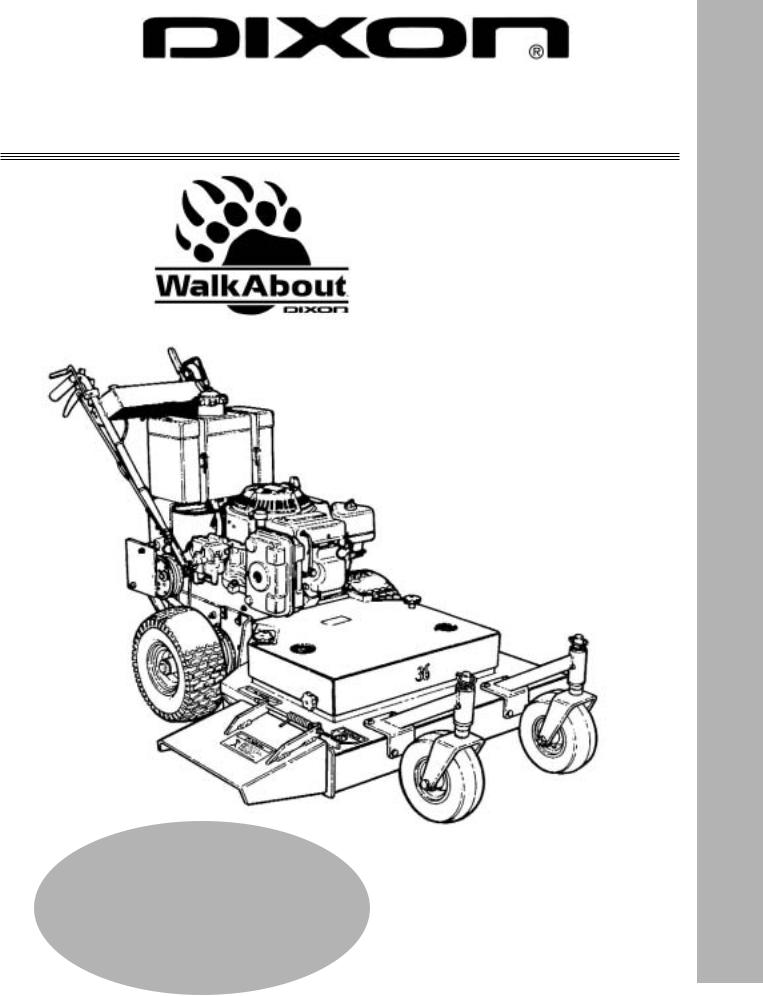
Dixon Industries, Inc. • Airport Industrial Park • Coffeyville, KS • 67337 620.251.2000 • www.dixon-ztr.com
36” & 48” Commercial
Belt-Drive Mowers
Congratulations on the purchase of your new
Dixon mower.
Before any warranty service can be authorized you must register this product with the manufacturer.
Manual Owner’s & Parts
© Dixon Industries Inc.

Dixon Industries, Inc. • Airport Industrial Park • Coffeyville, KS • 67337 620.251.2000 • www.dixon-ztr.com
|
|
|
Owner’s Manual For Dixon 36” & 48” |
|
Commercial Belt-Drive Mowers |
|
|
|
|
|
|
TABLE OF CONTENTS
About This Manual . . . . . . . . . . . . . . . . . . . . . . . . . . . . . . . . . . . . . . . . . . . . . . . . . . . . . . . . . . . . . . . . . . . . . . .4
Warranty . . . . . . . . . . . . . . . . . . . . . . . . . . . . . . . . . . . . . . . . . . . . . . . . . . . . . . . . . . . . . . . . . . . . . . . . . . . . . . .5
Safety Information
Training . . . . . . . . . . . . . . . . . . . . . . . . . . . . . . . . . . . . . . . . . . . . . . . . . . . . . . . . . . . . . . . . . . . . . . . . . .6
Before Use of Equipment . . . . . . . . . . . . . . . . . . . . . . . . . . . . . . . . . . . . . . . . . . . . . . . . . . . . . . . . . . . .6
Operation Of the Equipment . . . . . . . . . . . . . . . . . . . . . . . . . . . . . . . . . . . . . . . . . . . . . . . . . . . . . . . . . .7
Safety Information Decals . . . . . . . . . . . . . . . . . . . . . . . . . . . . . . . . . . . . . . . . . . . . . . . . . . . . . . . . . . .8
Operating The Mower
Operating Controls . . . . . . . . . . . . . . . . . . . . . . . . . . . . . . . . . . . . . . . . . . . . . . . . . . . . . . . . . . . . . . . . .9
Starting the Engine . . . . . . . . . . . . . . . . . . . . . . . . . . . . . . . . . . . . . . . . . . . . . . . . . . . . . . . . . . . . . . . .10
Going Forward . . . . . . . . . . . . . . . . . . . . . . . . . . . . . . . . . . . . . . . . . . . . . . . . . . . . . . . . . . . . . . . . . . .10
Turning The Mower . . . . . . . . . . . . . . . . . . . . . . . . . . . . . . . . . . . . . . . . . . . . . . . . . . . . . . . . . . . . . . . .11
Stopping The Mower . . . . . . . . . . . . . . . . . . . . . . . . . . . . . . . . . . . . . . . . . . . . . . . . . . . . . . . . . . . . . . .11
Going In Reverse . . . . . . . . . . . . . . . . . . . . . . . . . . . . . . . . . . . . . . . . . . . . . . . . . . . . . . . . . . . . . . . . .11
Mowing . . . . . . . . . . . . . . . . . . . . . . . . . . . . . . . . . . . . . . . . . . . . . . . . . . . . . . . . . . . . . . . . . . . . . . . . .11
Height Of Cut
Measuring . . . . . . . . . . . . . . . . . . . . . . . . . . . . . . . . . . . . . . . . . . . . . . . . . . . . . . . . . . . . . . . . . .12
Adjusting Blades . . . . . . . . . . . . . . . . . . . . . . . . . . . . . . . . . . . . . . . . . . . . . . . . . . . . . . . . . . . . .12
Adjusting Front Wheels . . . . . . . . . . . . . . . . . . . . . . . . . . . . . . . . . . . . . . . . . . . . . . . . . . . . . . . .12
Service And Maintenance Of The Mower
Maintenance Schedule . . . . . . . . . . . . . . . . . . . . . . . . . . . . . . . . . . . . . . . . . . . . . . . . . . . . . . . . . . . . .14
Fuel . . . . . . . . . . . . . . . . . . . . . . . . . . . . . . . . . . . . . . . . . . . . . . . . . . . . . . . . . . . . . . . . . . . . . . . . . . .15
Engine Oil . . . . . . . . . . . . . . . . . . . . . . . . . . . . . . . . . . . . . . . . . . . . . . . . . . . . . . . . . . . . . . . . . . . . . . .15
Air Filter . . . . . . . . . . . . . . . . . . . . . . . . . . . . . . . . . . . . . . . . . . . . . . . . . . . . . . . . . . . . . . . . . . . . . . . .15
Tire Pressure . . . . . . . . . . . . . . . . . . . . . . . . . . . . . . . . . . . . . . . . . . . . . . . . . . . . . . . . . . . . . . . . . . . .15
Blades . . . . . . . . . . . . . . . . . . . . . . . . . . . . . . . . . . . . . . . . . . . . . . . . . . . . . . . . . . . . . . . . . . . . . . . . . .15
Cleaning The Mower . . . . . . . . . . . . . . . . . . . . . . . . . . . . . . . . . . . . . . . . . . . . . . . . . . . . . . . . . . . . . .15
Lubrication Points . . . . . . . . . . . . . . . . . . . . . . . . . . . . . . . . . . . . . . . . . . . . . . . . . . . . . . . . . . . . . . . . .16
Service Adjustments
Wheel Brake Adjustments . . . . . . . . . . . . . . . . . . . . . . . . . . . . . . . . . . . . . . . . . . . . . . . . . . . . . . . . . .17
Wheel Brakes . . . . . . . . . . . . . . . . . . . . . . . . . . . . . . . . . . . . . . . . . . . . . . . . . . . . . . . . . . . . . . . . . . . .17
Engine To Blade Belt . . . . . . . . . . . . . . . . . . . . . . . . . . . . . . . . . . . . . . . . . . . . . . . . . . . . . . . . . . . . . .18
Blade To Blade Belt . . . . . . . . . . . . . . . . . . . . . . . . . . . . . . . . . . . . . . . . . . . . . . . . . . . . . . . . . . . . . . .19
Engine To Transmission Belt . . . . . . . . . . . . . . . . . . . . . . . . . . . . . . . . . . . . . . . . . . . . . . . . . . . . . . . .19
Safety Interlock System . . . . . . . . . . . . . . . . . . . . . . . . . . . . . . . . . . . . . . . . . . . . . . . . . . . . . . . . . . . .19
Troubleshooting Guide . . . . . . . . . . . . . . . . . . . . . . . . . . . . . . . . . . . . . . . . . . . . . . . . . . . . . . . . . . . . . . . . . . .20

NOTES
_______________________________________________
_______________________________________________
_______________________________________________
_______________________________________________
_______________________________________________
_______________________________________________
_______________________________________________
_______________________________________________
_______________________________________________
_______________________________________________
_______________________________________________
_______________________________________________
_______________________________________________
_______________________________________________
_______________________________________________
_______________________________________________
_______________________________________________
_______________________________________________
Dixon Industries, Inc. • Airport Industrial Park • Coffeyville, KS • 67337 • 620-251-2000 |
3 |
|
|
||
|
|
|

About This Manual
This owner’s manual is considered a permanent part of the mower. It must be available to all of the operators and/or person(s) servicing the mower. Should the mower be resold, this manual must remain with the mower.
All information, illustrations, and specifications contained in this manual were in effect at the time of publication. Dixon Industries, Inc. reserves the right to change, modify, and/or discontinue specifications and/or design without notice. If there is a change that has been made to your mower which is not shown or reflected in this manual, please see your authorized Bradley
Mower dealer before operating and/or servicing the equipment.
Congratulations on the purchase of your new Dixon commercial mower. We at Dixon
Industries, Inc. are confident that this mower will provide you with years of excellent performance, durability, and trouble free service when operated and maintained as directed in this manual.
Should you ever have any questions regarding the operation, maintenance, or safety of your mower, please contact your authorized Dixon Mower dealer who has been specially trained on operation and service of Dixon Mowers.
A space has been provided below to record information about your new Dixon Mower. Please take time to record such information for future reference, especially when you contact an authorized Dixon Mower dealer with questions.
Date Purchased: ____________________________________________________
Model Number: ____________________________________________________
Serial Number: ____________________________________________________
Purchased From: ____________________________________________________
____________________________________________________
4 |
Dixon Industries, Inc. • Airport Industrial Park • Coffeyville, KS • 67337 • 620-251-2000 |
|

DIXON® LIMITED WARRANTY POLICY
WalkAbout™ Mowers
DIXON® WALKABOUT™ MOWERS ARE WARRANTED AGAINST DEFECTS IN MATERIALS AND WORKMANSHIP AND PROVIDES FOR REPLACEMENT OR REPAIR OF PARTS INCLUDING LABOR COSTS. THIS WARRANTY IS SUBJECT TO THE FOLLOWING CONDITIONS AND LIMITATIONS.
1.Dixon® WalkAbout™ mowers are warranted for one (1) year from date of purchase for residential or commercial use.
2.Warranty applies only to original retail purchase of new and unused mowers and accessories.
3.All Dixon® warranty must be accomplished by authorized Dixon® dealers and in accordance with Dixon® warranty policy and allowances. All warranty claims must be approved by Dixon Industries, Inc.
4.Warranty does not apply to damage in transit or incidents of misuse, negligence, accidents, or alteration. The use of parts or components other than those supplied by Dixon Industries VOIDS ALL WARRANTY.
5.The following items are not covered by this warranty policy:
(a)Pick up and delivery charges for transportation of mower to and from an authorized Dixon® dealer’s place of business.
(b)Routine maintenance or adjustments.
(c)Belts, blades, tilters or tires.
(d)Engines - all engines used on Dixon® WalkAbout™ mowers are warranted by each individual engine manufacturer.
(e)Transmission - All transmissions used on Dixon® WalkAbout™ mowers are warranted by the transmission manufacturer.
(f)Any costs or expense of providing substitute equipment while repair work is being performed on a warranted mower.
6.There is no other express warranty. Implied warranties, including those of merchantability and fitness for a particular purpose are limited to the same duration if the express warranty and to the extent permitted by law any and all implied warranties are excluded. Liabilities for consequential damages under any and all warranties are excluded.
Dixon Industries, Inc. • Airport Industrial Park • Coffeyville, KS • 67337 • 620-251-2000 |
5 |
|
|
||
|
|
|

SAFETY INFORMATION
Read This Manual Carefully And Thoroughly Before Operating The Mower!
Training
1.Carefully and thoroughly read the owner’s manual. Allow adequate time to fully understand the controls and operation of the equipment.
2.Never allow anyone to operate the mower that has not read and fully understood the owner’s manual.
3.Do not carry passengers. Avoid mowing while people, especially children and pets are nearby, since rotating blades can throw rocks and other items with enough force to cause serious injury.
Before Use of Equipment
Operator:
Wear protective clothing while mowing. Long trousers and safety glasses will help reduce the risk of injury from thrown objects. It is recommended that steel toe shoes with aggressive soles or some other type of substantial footwear be worn to help protect your feet and maintain traction on slopes or uneven ground. Always wear hearing protection.
Mowing Area:
Thoroughly inspect the area where the equipment is to be used. Look for items such as stones, sticks, wire and other foreign objects. When struck by the mower, these and other objects my become projectiles that could lead to serous injury and/or death.
Mower:
For your safety and the long life of your mower, always inspect the mower before each use. Before inspection, make sure it is on a flat and level surface, the blades are disengaged, the ignition switch off with the key removed, and the spark plug wire is off of the spark plug(s) and hidden so that accidental contact can not be made,
General Condition:
·Walk around the mower looking for any fluid spills or leaks on or underneath the mower. Remove any and all excessive debris, dirt, and/or fluids.
·Look for signs of damage or excessive wear. Check the tightness of all nuts, bolts, pins, and screws. Tighten any that may be loose and replace any that may have been lost during use.
·Be sure the safety interlock controls are operating properly so that the engine can not be started unless the ground speed control lever is in neutral and the blades disengaged.
·Check the mower blades for any damage or abnormal wear and replace in sets so that they are balanced.
·Check the tire pressure on all four tires. See page 15 for details.
·Check all belts for proper wear and correct tension. See pages 17-19 for details.
·Check engine oil and air filters as recommended in the engine manufacturers’ operators manual.
6 |
Dixon Industries, Inc. • Airport Industrial Park • Coffeyville, KS • 67337 • 620-251-2000 |
|

Operation of Equipment
DANGER: GASOLINE IS HIGHLY FLAMMABLE AND EXPLOSIVE. DO NOT ADD FUEL WHILE THE
!ENGINE IS RUNNING OR IS HOT. KEEP OPEN FLAMES, SPARKS, AND HEAT AWAY FROM THE FUEL AND STORE FUEL IN CONTAINERS SPECIFICALLY DESIGNED FOR THAT PURPOSE. ADD FUEL OUTDOORS ONLY AND IF THE FUEL IS SPILLED, DO NOT START THE ENGINE. MANUALLY PUSH THE MOWER AWAY FROM THE SPILL AND IMMEDIATELY WIPE UP.
Do not operate the engine in a confined space where dangerous carbon monoxide fumes can collect. Carbon monoxide is odorless, tasteless, and can be fatal.
Mow only in daylight.
Do not park on hills without the use of wheel blocks.
Make sure the mower is in neutral and the blades are disengaged before attempting to start the engine.
Do not stop or start suddenly when going uphill. Never use riding attachments on slopes since there is an increase risk that they might roll over.
Avoid steep slopes and use extreme caution when changing directions or speed when operating on a slope.
Be extremely careful when operating on a slope or when the grass is damp or wet. Reduced traction could cause sliding. Never mow by pulling the mower back towards you...you might slip.
Watch for traffic when crossing surfaces other than grass. (i.e. transporting,) loading a trailer or vehicle, or when the mower is not in use.
Never operate the mower with defective guards, shields, or without the safety devices securely mounted in place.
Never direct discharge of material toward bystanders nor allow anyone near the mower while in operation.
Do not change the governor settings or over speed the engine.
Always stop the engine whenever you leave the mower, even for a moment.
To help reduce the risk of a fire hazard, keep the engine and the area around the engine free of grass, leaves, or any other type of foreign material.
Beware of cutting edges. Always wear gloves for safety when performing blade maintenance activities. Beware on multiple blades units since the rotation of one blade may cause the rotation of the other blade.
Do not store or operate the mower with the grass chute deflector in raised position. Serious injury could occur.
Dixon Industries, Inc. • Airport Industrial Park • Coffeyville, KS • 67337 • 620-251-2000 |
7 |
|
|
||
|
|
|
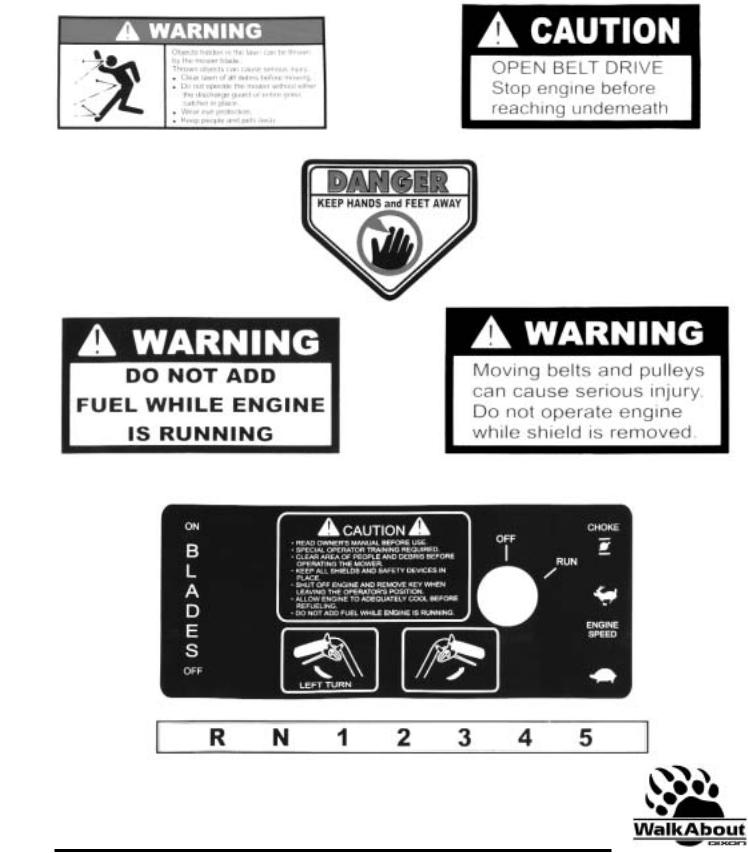
SAFETY INFORMATION DECALS
The following labels are intended to alert you to potential hazards and to provide you with important safety information. Should these decals become difficult to read or are missing from the mower, contact your Dixon® WalkAbout™ Mower dealer for a replacement.
8 |
Dixon Industries, Inc. • Airport Industrial Park • Coffeyville, KS • 67337 • 620-251-2000 |
|
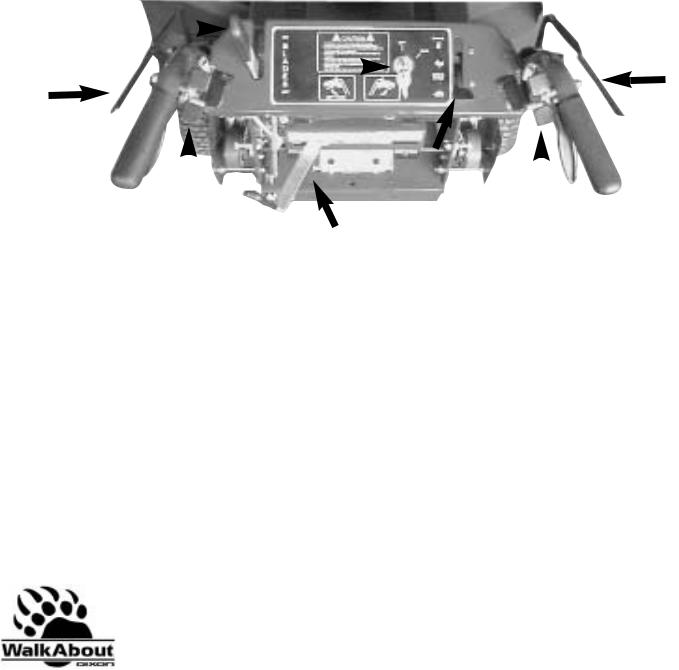
OPERATING THE MOWER
It is recommended that before you operate the mower, you allow adequate time to fully understand the controls and operation of the equipment. When reading this manual, it is recommended that you do so with the equipment nearby for quick orientation, reference of controls and maintenance adjustments.
Operating Controls
Before continuing to read the manual, it is recommended that you take adequate time to identify the controls of the mower.
B |
C |
|
|
|
|
D |
|
|
|
|
B |
|
|
|
|
|
|
|
|||||
|
|
|
|
|
|
|
|||||
|
|
|
|
|
|
|
|
|
|||
|
|
|
|
|
|
|
|
||||
|
|
|
|
|
|
|
|
||||
|
|
|
|
|
|
|
|
|
|
||
|
|
|
|
|
|
|
|
E |
|
|
|
|
|
|
|
|
|
|
|
|
|
|
|
|
|
A |
F |
A |
|||||||
|
|
|
|
|
|
|
|
|
|||
“A” |
Traction Lever Locks |
|
|
“D” Key Switch |
|||||||
“B” |
Operator Presence Controls |
|
|
“E” |
Throttle/Choke Control |
||||||
“C” |
Blade Control Lever |
|
|
“F” |
Gear Shift Lever |
||||||
Dixon Industries, Inc. • Airport Industrial Park • Coffeyville, KS • 67337 • 620-251-2000 |
9 |
|
|
||
|
|
|
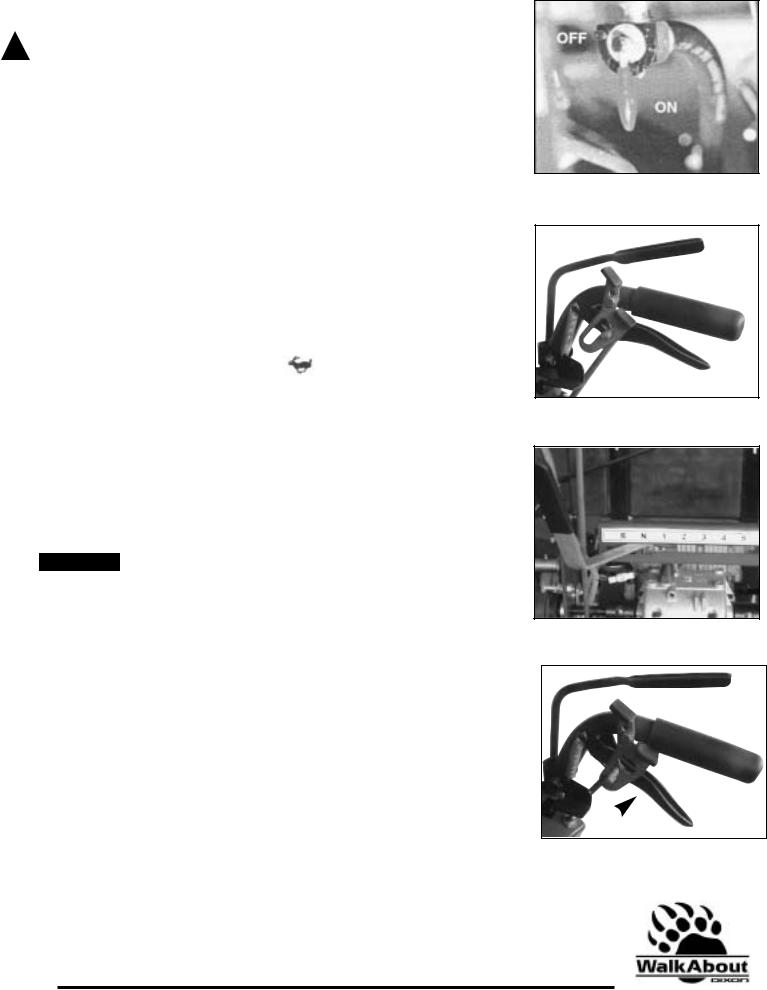
Starting The Engine:
!DANGER: DO NOT OPERATE THE ENGINE IN A CONFINED SPACE WHERE DANGEROUS CARBON MONOXIDE FUMES CAN COLLECT. CARBON DIOXIDE IS ODORLESS, TASTELESS, AND CAN BE FATAL.
After going through the steps as discussed on pages (6) and (7), you are now ready to start the engine. NOTE: THIS UNIT WAS SHIPPED WITHOUT THE GAS, BE SURE TO ADD FRESH GAS AND TO DOUBLE CHECK THE OIL IN THE ENGINE BEFORE ATTEMPTING TO START THE MOWER.
1.Make sure that the shut off valve, located at the bottom of the fuel tank is in the “ON” position (figure 2).
2.Make sure that the traction control lever are in the neutral position(figure 3)
3.Make sure that the gear shift lever is in the neutral “N” position (figure 4)
4.Make sure that the blade control lever is in the “OFF” position. NOTE: The safety interlock system will prevent the engine from being started if the blade control lever is not in the “OFF” position and the gear shift lever is not in the neutral “N” position.
5. Slide the engine speed control to the “ |
“ position, or to “CHOKE” if the |
engine is cold. |
|
6.Turn the key clockwise to the “RUN” position.
7.Slowly pull the start cord on the engine until just past compression. STOP! Return the start cord and then pull firmly with a smooth, steady motion to start the engine.
8.When the engine starts to run, slowly return the engine speed control out of “CHOKE” to the desired engine speed.
Going Forward:
CAUTION Become totally familiar with the operation and characteristics of the mower before attempting to actually mow with it.
1.Making sure that the traction control levers are in the neutral position, push down and hold the operator presence control lever “A” on the handle grips with one hand (Figure 5).
2.With the other hand, move the gear shift lever to the desired speed. “1” is slow and “5” is for transporting the mower between mowing areas (Figure 4). It is recommended that you start out in “1” and then increase your ground speed to match the mowing conditions.
3.Release the traction control lever locks by squeezing up both traction control levers “C” only as much as needed while at the same time applying forward pressure in the traction control lever locks “B” with your thumbs.
4.Slowly and evenly, let both traction control levers down simultaneously and the mower will start to go forward (Figure 5). NOTE: If the operator lets go of both operator presence control levers while either the blade control lever is in “ON”, and/or the gear shift control lever is out of the neutral position the safety interlock system will stop the engine. To restart the mower, reset all controls to the “OFF” position and neutral “N” positions.
Figure 2
Figure 3
Figure 4
 A
A
 B
B
C
Figure 5
10 |
Dixon Industries, Inc. • Airport Industrial Park • Coffeyville, KS • 67337 • 620-251-2000 |
|

Turning The Mower
To turn the mower in the direction you want to go, gently squeeze the side’s traction control lever (i.e. to go right, squeeze the right traction control lever; to go left, squeeze the left traction control lever). The more a particular traction control lever is squeezed, the sharper a turn the mower will make.
Stopping The Mower
To stop the mower, gently and evenly squeeze up on both of the traction control levers until the mower comes to a complete stop. Then with your thumbs, push down on the traction lever locks until the levers are securely locked in the neutral position. While still holding down with one hand the operator presence controls, move the gear shift lever to the “N” position with the other hand. If the operator is leaving the operator’s position behind the mower for any reason, disengage the blades, shut the engine off, and remove the key.
If you are leaving the operator’s position, try to park the mower on level ground. If it is not possible to do such, be sure to block the wheels to prevent the mower from rolling away.
Using The Reverse Assist
1.Slowly and evenly squeeze up on both control levers until the mower comes to a complete stop and then with your thumbs, push down on the traction lever locks until the levers are securely locked in the neutral position.
2.While still holding down the operator presence control with one hand, use the other and pull the blade control lever to the “OFF” position.
3.Shift the gear shift lever to the reverse “R” position.
4.Release the traction control lever locks by squeezing by both traction control levers only as much as needed while at the same time, applying forward pressure on the traction control lever locks with your thumbs.
5.Slowly and evenly, let both traction control levers down simultaneously and the mower will start to go in reverse. Always use extreme caution when moving the mower backwards and never move the mower downhill backwards.
6.To stop the mower, slowly and evenly squeeze up on both control levers until the mower comes to a complete stop and then with your thumbs, push down on the traction lever locks until the levers are securely locked in the neutral position and return the gear shift lever to neutral “N”.
Mowing
!DANGER: THOROUGHLY INSPECT THE AREA WHERE THE EQUIPMENT IS TO BE USED. LOOK FOR ITEMS SUCH AS STONES, STICKS, WIRE, AND OTHER FOREIGN OBJECTS. WHEN STRUCK BY THE MOWER, THESE AND OTHER OBJECTS MAY BECOME PROJECTILES THAT COULD LEAD TO SERIOUS INJURY AND OR DEATH. CLEAR AREA OF ALL DEBRIS AND KEEP PEOPLE AND PETS AWAY.
!DANGER: DO NOT OPERATE THE MOWER WITH DEFECTIVE GUARDS, SHIELDS, OR WITHOUT THE SAFETY DEVICES SECURELY IN PLACE.
For the highest quality of cut and performance, always mow with the engine at full throttle. Quality of cut may be determined by the ground speed and speed of the mower. Generally, the slower the mower travels across the terrain, the better the cut.
With the mower at the beginning of the area to be mowed and traction control levers in the neutral position, hold down with one hand the operator presence control.
With the other hand, slowly push the blade control lever forward to the “ON” position.
Move the gear shift lever to the desired speed. Always begin at a slow ground speed and increase only as the condition of the terrain warrants.
Slowly and evenly, engage the traction control levers and begin mowing.
To stop mowing, slowly and evenly squeeze up on both traction control levers until the mower comes to a complete stop and then with your thumbs, push down on the traction lever locks until the levers are securely locked in the neutral position. Return the gear shift lever to the neutral “N” position.
Pull the blade control lever back to the “OFF” position.
Dixon Industries, Inc. • Airport Industrial Park • Coffeyville, KS • 67337 • 620-251-2000 |
11 |
|
|
||
|
|
|

Changing The Height Of Cut:
!DANGER: BEFORE MAKING ANY ADJUSTMENTS AND/OR SERVICING YOUR MOWER, MAKE SURE THE MOWER IS ON LEVEL GROUND, BLADES DISENGAGED, KEYS REMOVED, AND THE ENGINE OFF WITH THE SPARK PLUG WIRE(S) REMOVED FROM THE SPARK PLUGS(S) TO PREVENT ACCIDENTAL CONTACT.
When your Dixon walkabout mower is shipped from the factory, the mowing height is set at 2-1/2”. The mowing height may be raised or lowered using a combination of front wheel spacers and blade bolt assembly spacers. It is recommended that you first set your height of cut to the highest level using the blade spacers and then lower the height of cut using the front wheel spacers.
Measuring The Height Of Cut:
!DANGER: BEFORE MAKING ANY ADJUSTMENTS AND/OR SERVICING YOUR MOWER, MAKE SURE THE MOWER IS ON LEVEL GROUND, BLADES DISENGAGED, KEYS REMOVED, AND THE ENGINE OFF WITH THE SPARK PLUG WIRE(S) REMOVED FROM THE SPARK PLUGS(S) TO PREVENT ACCIDENTAL CONTACT.
CAUTION Beware of the cutting edges on the blades. The rotation of one blade may cause the other blade(s) to rotate. Always wear work gloves when handling blades.
1.Park the mower on level ground.
2.With the blade control lever in the “OFF” position, the engine off with the key removed, and the spark plug wire (s) removed from the spark plug(s), reach through the discharge chute and slowly rotate the blade so that the length of the blade is going from the front of the mower towards the rear.
3. Using a tape measure or small ruler, measure the distance from the front tip of the blade’s cutting edge to the ground. As a general rule, if measuring the cutting height on a hard surface such as concrete, the mower will usually mow about 1/4” lower in grass due to the weight of the machine.
Removing And Adjusting The Blades:
CAUTION Beware of the cutting edges on the blades. The rotation of one blade may cause the other blade(s) to rotate. Always wear work gloves when handling blades.
1.Park the mower on level ground and block the rear wheels to prevent accidental rollback.
2.Raise the front end of the mower using a jackstand
3.Using two (2) 15/16” box end wrenches, use one wrench to loosen nut “A” while holding blade bolt “C” with the other wrench (Figure 6).
4.Slide the blade bolt down through the mower deck and out.
5.To raise the blades to the height desired, remove the appropriate amount of spacers from the blade bolt. Example: If the height of cut needs to be raised 1/2”, move two (2) of the 1/4” spacers “B” on each blade from underneath the mower (Figure 6) to the top of the mower (Figure 7).
6.Reinsert the blade bolt through the cutting deck.
7.Install the blade spacers that were removed, back onto the blade bolt followed by the nut and tighten (Figure 6). IMPORTANT: The amount of spacers should always be the same on each blade bolt. Never put the spacers below the blade.
Adjusting The Front Wheels: (refer to Figure 8)
1.Raise and support the front of the mower with a jackstand.
2.While supporting the front wheel with one hand, remove the flip pin from the wheel shaft.
3.Remove the wheel from the front wheel support arm being careful not to loose the spacers.
4.Remove the amount of spacers desired to lower the height of cut.
5.Reinsert the wheel through the support arm.
6.Reinstall the spacers on the top that were removed from the bottom and then secure with the flip pin.
7.To raise the height, repeat steps 1-3, but take the spacers from the top of the wheel support arm, and put them on the bottom.
12 |
Dixon Industries, Inc. • Airport Industrial Park • Coffeyville, KS • 67337 • 620-251-2000 |
|
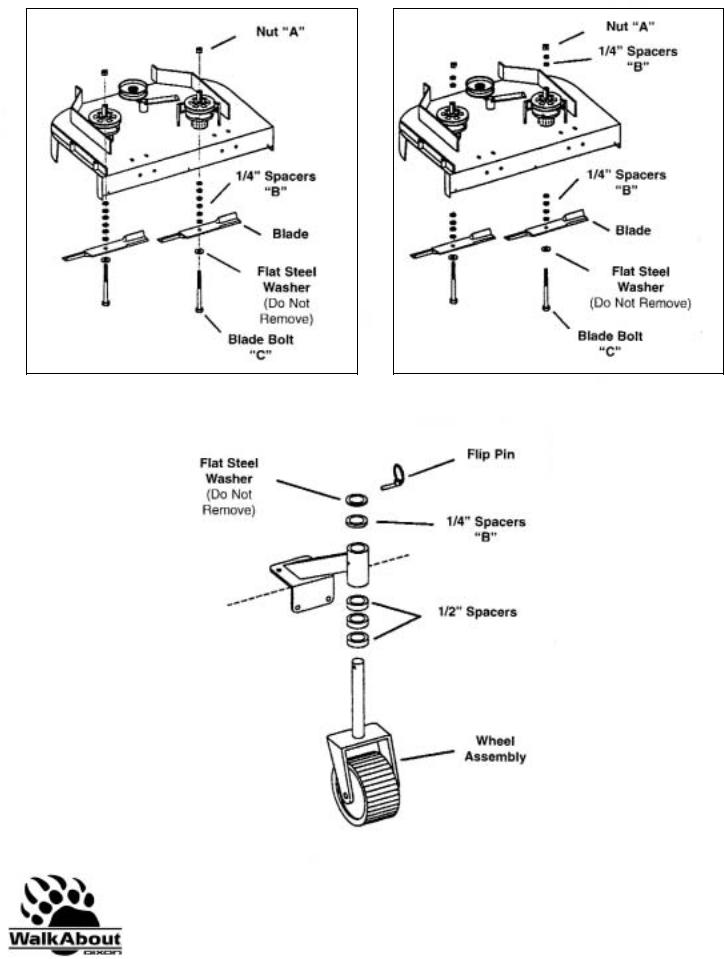
Figure 6 |
Figure 7 |
||
|
|
|
|
|
|
|
|
Figure 8
Dixon Industries, Inc. • Airport Industrial Park • Coffeyville, KS • 67337 • 620-251-2000 |
13 |
|
|
||
|
|
|

GENERAL MAINTENANCE
Proper maintenance and adjustment of your Dixon® WalkAbout™mower is necessary to keep the mower in good and safe condition. The maintenance of the mower is the responsibility of the owner/operator and must be performed at regular intervals. When replacing any parts of servicing your mower, be sure to use only genuine Dixon® WalkAbout™ mower replacement parts to assure quality and performance of your mower.
DANGER: BEFORE MAKING ANY ADJUSTMENTS AND/OR SERVICING YOUR MOWER, MAKE SURE THE MOWER IS ON LEVEL GROUND, BLADES DISENGAGED, KEY REMOVED, AND THE ENGINE OFF WITH THE SPARK PLUG WIRE(S) REMOVED FROM THE SPARK PLUGS(S) TO PREVENT ACCIDENTAL CONTACT. IF ADJUSTMENT OR MAINTENANCE IS BEING PERFORMED AFTER OPERATION OF THE MOWER, ALLOW THE UNIT TO COOL SINCE HEAT BUILD UP COULD CAUSE SEVERE BURNS.
Maintenance Schedule
|
|
|
|
|
|
|
|
Time Interval |
|
|
|
|
||
|
|
|
|
|
|
Break-in |
Every 8 |
|
Every 40 |
Every 100 |
Every 200 |
|||
|
|
|
Procedure |
|
|
|||||||||
|
Item |
|
|
|
||||||||||
|
|
|
|
hours |
|
hours |
hours |
|
hours |
|||||
|
|
|
|
|
(first 5 hrs) |
(Daily) |
|
(Weekly) |
(Bi-weekly) |
|
(Monthly) |
|||
|
|
|
|
|
|
|
|
|
||||||
|
|
|
|
|
|
|
||||||||
|
|
|
|
|
|
|
|
|
|
|
|
|
|
|
|
Belts |
Inspect (adjust if needed) |
|
|
• |
• |
|
|
|
|
|
|
|
|
|
Blades |
Inspect and Sharpen |
|
|
|
• |
|
|
|
|
|
|
|
|
|
Engine Air Filter |
Inspect (See Engine Owner’s Manual) |
|
|
|
• |
|
|
|
|
|
|
|
|
|
Engine Cooling Areas |
Clean (See Engine Owner’s Manual) |
|
|
|
|
|
|
• |
|
|
|
|
|
|
|
|
|
|
|
|
|
|
|
|
|
|
|
|
|
Engine Oil |
Check(See Engine Owner’s Manual) |
|
|
|
• |
|
|
|
|
|
|
|
|
|
|
|
Change (See Engine Owner’s Manual) |
|
|
• |
|
|
|
• |
|
|
|
|
|
Engine Oil Filter |
Change (See Engine Owner’s Manual) |
|
|
• |
|
|
|
|
|
• |
|||
|
|
|
|
|
|
|
|
|
|
|
|
|
|
|
|
Engine Spark Plug (s) |
Inspect (See Engine Owner’s Manual) |
|
|
|
|
|
|
|
|
• |
|||
|
|
|
|
|
|
|
|
|
|
|
|
|
|
|
|
Fuel Filter |
Replace |
|
|
|
|
|
|
• |
|
|
|
|
|
|
|
|
|
|
|
|
|
|
|
|
|
|
|
|
|
Fuel Line |
Check |
|
|
|
|
|
|
• |
|
|
|
|
|
|
|
|
|
|
|
|
|
|
|
|
|
|
|
|
|
|
|
Replace |
|
|
|
|
Every 2 years |
|
|
|
|
||
|
|
|
|
|
|
|
|
|
|
|
|
|
|
|
|
|
|
|
|
|
|
|
|
|
|
|
|
|
|
|
Grease Fittings |
Refer to Page 16 |
|
|
|
|
|
|
|
|
|
|
|
|
|
|
|
|
|
|
|
|
|
|
|
|
|
|
|
|
Hardware |
Check for proper tightness |
|
|
• |
|
|
• |
|
|
|
|
|
|
|
|
|
|
|
|
|
|
|
|
|
|
|
|
|
|
Mower Main Frame |
Remove debris from under belt cover |
|
|
|
• |
|
|
|
|
|
|
|
|
|
|
|
|
|
|
|
|
|
|
|
|
|
|
|
|
Safety Interlock System |
Check Operation and Switches |
|
|
|
• |
|
|
|
|
|
|
|
|
|
|
|
|
|
|
|
|
|
|
|
|
|
|
|
|
Tires |
Check Air Pressure |
|
|
|
|
|
• |
|
|
|
|
|
|
|
|
|
|
|
|
|
|
|
|
|
|
|
|
|
14 |
Dixon Industries, Inc. • Airport Industrial Park • Coffeyville, KS • 67337 • 620-251-2000 |
|
